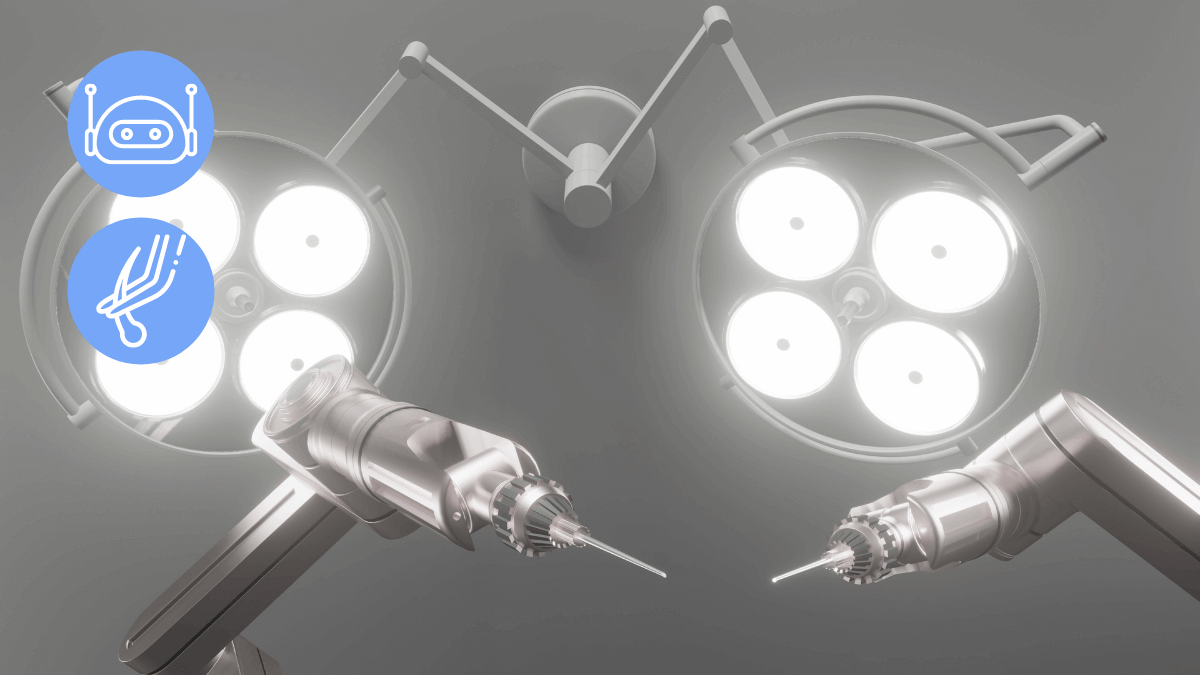TL;DR
➡ The ARTAS Robotic Hair Transplant System is an FDA-approved hair transplant system with robotic arms and AI systems that operate during surgery.
➡ In a standard comparison, this robotic system provides the same risks and potentially the same effectiveness as an expert doctor.
➡ ARTAS Robots lack the varieties a human surgeon can use in FUE techniques such as DHI, NeoGraft, or Sapphire FUE.
➡ As for their price, robot surgeons cost two times as much as FUE techniques without showing any clear superiorities such as being quicker.
The ARTAS Robotic Hair Transplant System, which was introduced in 2007, has become highly popular among hair loss patients over the years.
There is no doubt that advancements in medical technologies and robotics equal fewer errors and more optimized processes.
So robotic hair transplants should be better than traditional hair transplant techniques, right?
..
Well, not necessarily.
In this blog, I will go over these and explain in detail:
Table of Contents
Let’s get down to the specifics of the topic and thoroughly answer any questions you might have, starting with the basics:
What Is ARTAS?
The ARTAS Robotic Hair Transplant System is an advanced robotics device designed to automate and improve hair restoration surgeries. It is capable of scanning and mapping your scalp for 3D illustrations of your restored hairline and automated follicle harvesting processes.
Equipped with high-resolution microscopic cameras and capable AI systems, it offers hair restoration surgeons a helping hand in working towards quick and improved results.
Who Invented ARTAS?
In 2007, dermatologist doctors William Rassman and Robert Bernstein, who already were leading names in the hair restoration field, introduced the ARTAS system as a viable method for assisting hair transplant surgeries.
It wasn’t until 2011 that ARTAS was approved for surgical use by the U.S. Food and Drug Administration (FDA) and was officially used in FUE surgeries.
At first, it was only equipped with the technology of autonomous hair extraction, which was already working wonders for both patients and physicians.
By 2014, the device and its systems were updated with more advanced and sophisticated features.
The first of these features was called ARTAS Hair Studio, which helped surgeons simulate results in a 3D environment to share with the patients.
The other one was called Advanced Site Making, which made an in-depth analysis of the recipient site to suggest the placement of hair grafts.
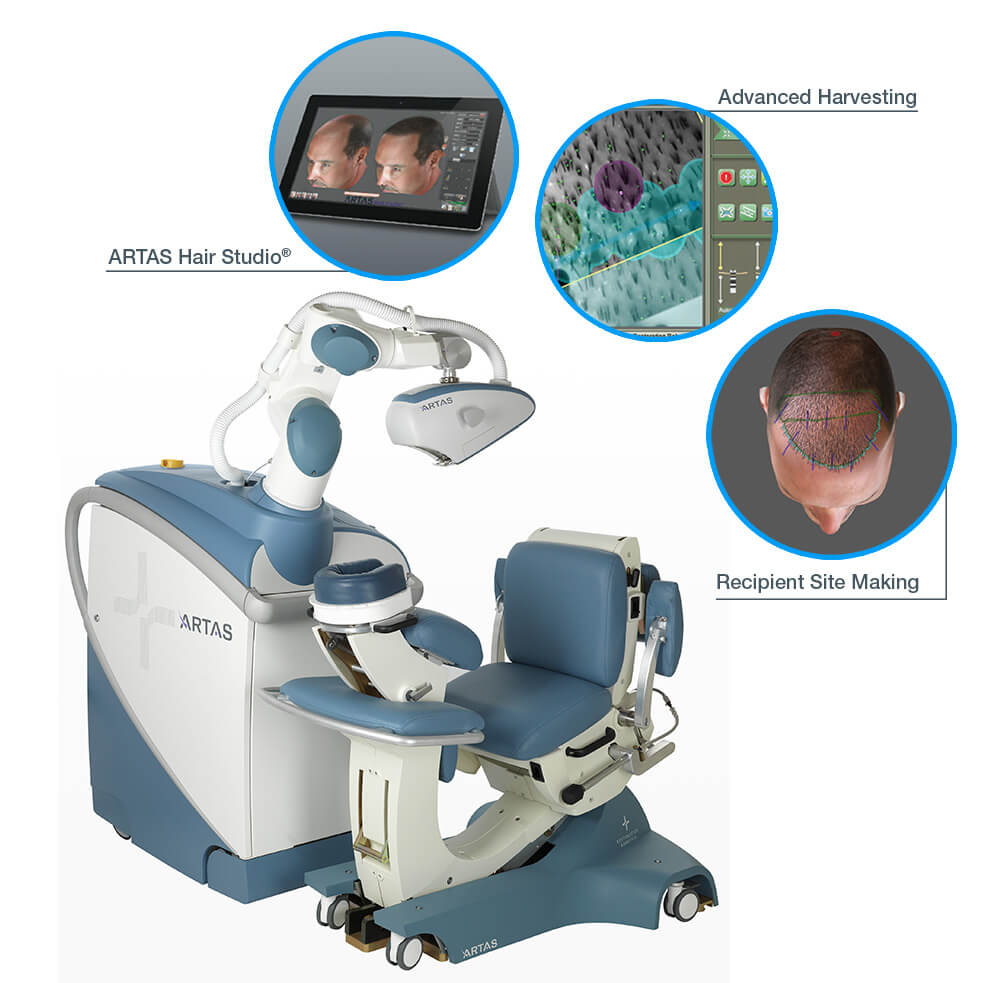
Of course, new systems and features are always being developed for the ARTAS device to change the future of hair transplantation for the better.
How Does the ARTAS Robotic Hair Transplant System Work?
Before we start comparing ARTAS with traditional hair restoration methods or other advanced techniques, we need to go over how exactly this device works.
I’ll explain each of the device’s features in the order they are used during the surgery, starting with:
ARTAS Hair Studio
As I’ve just mentioned, ARTAS’s Hair Studio feature allows you to have a realistic digital depiction of your end results.
In order to do that, the staff of the clinic first take pictures of your scalp to upload to the system. Then, the system builds your scalp in 3D, which you will be able to view and examine through the software on a tablet.
Using this software, you can take a look at what your hairline will look like when it’s restored. And with the help of your physician, you can decide on the course of action.
Once that’s done, you are prepared for graft harvesting.
Graft Extraction with ARTAS
The ARTAS system also contains a custom seat designed for you to sit and place your head under the machine.
Once you’re ready to go with ARTAS right above the donor area on the back of your scalp, the harvesting begins. Through the microscopic cameras built into the device, each of your hair follicles is monitored closely in real-time, and the algorithm guides the device as it harvests individual hair grafts.
Thanks to this much more precise and in-detail harvesting, your donor area is left intact with minimal scars.
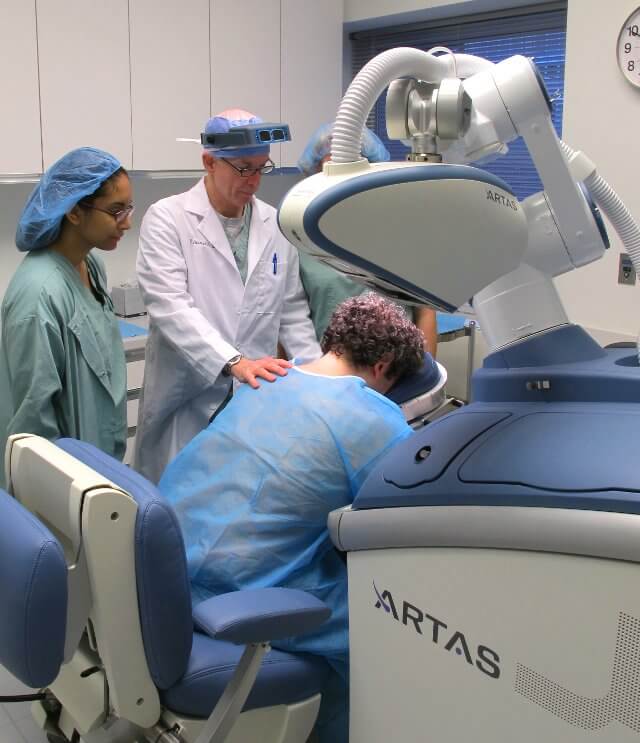
Recipient Site Making With ARTAS
Contrary to many patients’ assumptions, the ARTAS system doesn’t currently implant the harvested grafts into the recipient area, at least not yet.
Instead, the hair restoration surgeon uses an implanter or forceps to plant each hair follicle individually by hand.
However, this doesn’t mean ARTAS doesn’t assist the surgeon in this part of the surgery.
Thanks to ARTAS Hair Studio and the hairline you’ve decided on before graft harvesting, the system analyzes the best areas to plant the extracted grafts and guides the surgeon.
How Long Does ARTAS Robotic Hair Transplant Surgery Take?
The exact duration of a hair transplant surgery using the ARTAS robotic system really depends on the number of grafts you’re going to receive, but on average, it will take 4-8 hours for the whole procedure to be complete.
What Are the Side Effects of Robotic Hair Transplants?
The inclusion of the ARTAS robotic system or any other robotic assistance doesn’t cause any specific side effects during a hair restoration surgery, but the general side effects from hair transplantation apply to this technique.
These side effects include:
- Pain and tightness
- Redness and swelling
- Bleeding
- Hair transplant infections
- Hair transplant scabs
- Crust formations
- Itching
- Folliculitis
How Effective Is ARTAS Robotic Hair Transplant?
At first look, it may look like an ARTAS Robotic hair transplant mostly has the same effectiveness rate as a normal hair transplant, which is not entirely wrong. At its core, it’s a robotic system that performs the same surgery.
However, there are more factors to consider here: ARTAS Robotic hair transplant can make mistakes in accuracy and precision.
According to research, robotics indicate an 89.6% accuracy for hair graft detection in the 4 mm hair length phantom and a 97.4% accuracy for the 2 mm hair length phantom. Regarding hair base selection, which pertains to the target point of the needle punch moving unit, the precision was measured at 46% for a 4 mm hair length and 76% for a 2 mm hair length.
These findings may not seem like much to patients. However, I can say from my medical experience that an expert surgeon who has done over 100.000 surgeries has a much higher rate of accuracy and precision.
Ultimately, ARTAS Robotic hair transplants are very effective, but they have yet to exceed the skills of an expert surgeon as of their development level in 2024.
So, to compare a robotic transplant and a normal one:
Is Robotic Hair Transplant Better?
Answering this question is a bit more difficult than a simpler discussion of man versus the machine.
In short, I can say it is better than some techniques in terms of results, but it is not superior to some techniques if done right.
When you browse the internet or directly consult a clinic for an answer, you don’t get a straight answer, unfortunately.
These clinics, which operate with ARTAS robotic hair transplant systems, actually deceive you.
Here’s how:
How Do Clinics That Offer ARTAS Deceive You?
It is one thing to tell the truth, and it is another thing to tell the whole truth.
Often, on their websites, clinics explain their ARTAS procedures, answer a few questions, and compare ARTAS to other methods.
They compare ARTAS to FUT surgeries but mostly avoid mentioning FUE and its advanced variations.
👉 This is because the answer to “Is ARTAS better than manual hair transplant surgeries?” changes depending on the hair transplant technique you’re comparing it with.
Let’s explore the different comparisons and both answers:
Yes – ARTAS vs. Strip Surgeries
Strip Surgery, also known as FUT (Follicular Unit Transplantation), is a hair transplantation method that extracts a strip of tissue with hair grafts from the donor area to harvest individual follicles.
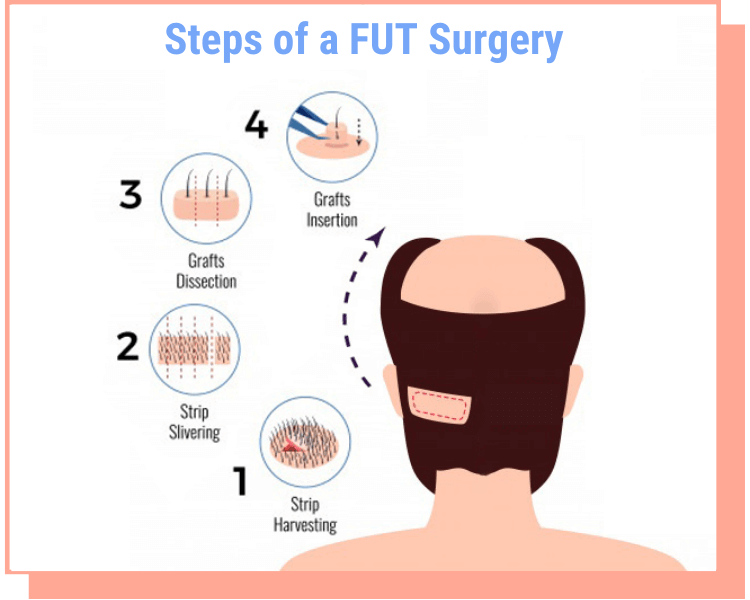
This strip of tissue is usually large and results in a linear scar on the back of the patient’s head.
However, because it requires less precision, expertise, and effort than FUE surgeries, it is widely preferred by clinics as a hair restoration method.
In most comparisons where ARTAS is highlighted as the superior method, the compared method is FUT; and yes, ARTAS is a better hair transplant technique than FUT because it leaves fewer scars on the donor area and offers more natural results.
But so does FUE:
No – ARTAS vs. Advanced FUE Techniques
In an FUE (Follicular Unit Excision) surgery, on the other hand, hair grafts are individually harvested using a puncher, just like it is done in ARTAS robotic hair transplants.
Except in FUE, it is the surgeon who harvests these individual follicles.
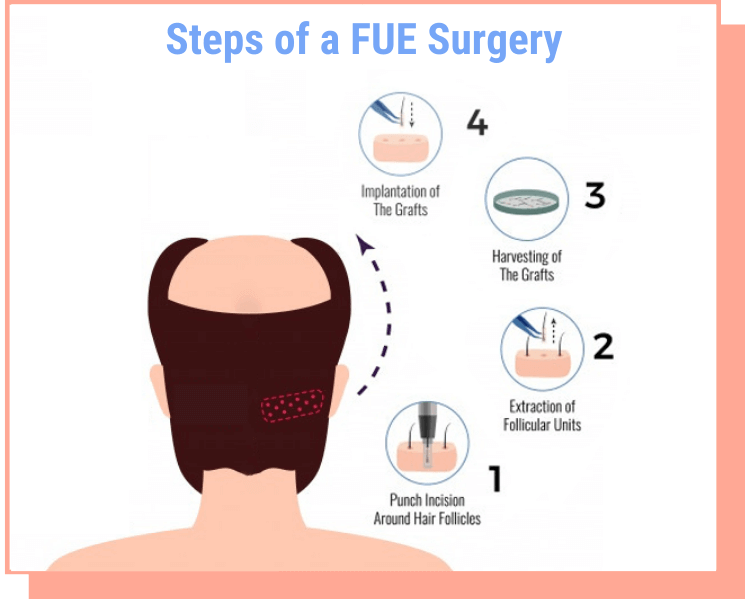
The ARTAS robotic hair transplant system harvests hair autonomously and with minimal error, but so does an expert FUE surgeon.
💡 Plus, most clinics that offer ARTAS have much higher prices compared to FUE surgeries because of all the equipment involved.
So, no, ARTAS is NOT a better technique than FUE and its advanced variations, such as DHI, NeoGraft, or Sapphire FUE, considering comparison points such as scars, results, and prices.
It’s not worse, too. At the current state of ARTAS systems, robotic hair transplant surgeries offer very similar results to FUE surgeries.
How Much Does ARTAS Robotic Hair Transplant Cost?
An ARTAS Robotic Hair Transplant surgery will cost twice as much as FUE and triple that of FUT surgeries, with the average price for 2000 graft procedures being $10,000 and the pricing across Europe and North America changing between $7,000 and $24,000.
So, regardless of the cost of a hair transplant in any country, you’ll still be paying at least twice as much for an ARTAS Robotic hair transplant.
The Catch With Robotic Hair Transplants…
Yes, robotic hair transplants are definitely the future.
But they’re not completely present.
There is no evidence that surgery with the ARTAS Robotic System will provide quicker or better results.
But there is enough evidence to say it is overpriced, and you can achieve the same, if not better, results going for expert FUE surgeons with more affordable pricing.
UnitedCare – FUE Surgeries With Actual Doctors, Expert Staff, and Holistic Treatment
As a dermatologist duo (Dr. Kubra and Dr. Utkan Kiziltac) who have treated over 50,000 patients, we’ve started a hair clinic to restore the natural look of hair loss patients with a holistic approach.
Using top-of-the-line techniques and equipment that the top 5% of clinics in the world use, such as Sapphire FUE, DHI, and bio-enhancements, we ensure maximum graft survival and improved results.

We’re just a click away: 👇
Restore your natural look with the proper tools and expert doctors.
UnitedCare’s dermatosurgeons provide you with a holistic approach to hair transplants:
Frequently Asked Questions (FAQs)
Is ARTAS Good for FUE?
ARTAS replaces the manual harvesting part of an FUE surgery and improves the results achieved due to being much more precise during extraction. The majority of experts agree that ARTAS is great for further improving FUE and will replace manual operations in hair restoration in the future.
Is ARTAS Better Than Manual?
ARTAS Robotic Hair Transplant System is significantly better and more precise than the average physician operating the manual graft harvesting process. In addition, it can project 3D simulations and help establish a much more accurate prediction of results.
Is ARTAS Better Than NeoGraft?
Both ARTAS and NeoGraft work in a similar way, with the only difference being the operator of the harvesting phase of a hair transplant surgery. Although ARTAS is much more precise than the average NeoGraft hair restoration physician, it has been observed that an expert hair transplant surgeon is more skilled than ARTAS.
Does ARTAS Hair Transplant Work?
Essentially, yes, ARTAS robotic hair transplant does exist, and it works. However, what we mean by “work” is that it can perform a hair transplant at entry level. It still has a lot of way to go as it has a considerable rate of making mistakes in accuracy and precision. As a result, it is far behind an actual expert human surgeon in terms of results, scar, and especially pricing.
